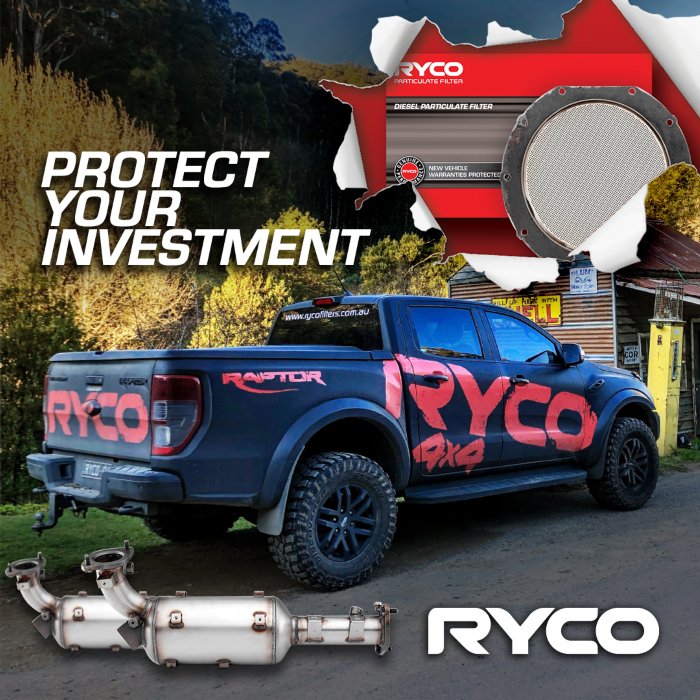
Diesel Particulate Filters are an essential component of modern turbo-diesel engines, but don’t necessarily operate at their peak in suburban environments, made up of shorter trips. Here, we look at how to get the best from turbo-diesel engines and how to help get the most out of your DPF’s service life.
Most four-wheel drives and utes sold after 2006 are equipped with common rail direct injected turbo-diesel engines. These engines offer greater power and economy than their petrol rivals, improving low-down pulling power and range.
But to keep emissions in check, and ensure the smooth operation of these sophisticated engines, they are also equipped with a Diesel Particulate Filter (DPF) – a vital exhaust system component.
This important emissions device reduces the level of particulates emitted through the tailpipe. But, as diesel engines work more efficiently under load and at optimal operating temperatures, suburban driving and short-trip behaviours can see the DPF operating in less-than-optimal conditions.
Typically, short trips and suburban driving do not bring the engine and exhaust system to their optimal operating temperatures, or allow the DPF regeneration process to kick in. In turn, this promotes less efficient combustion and higher concentrations of exhaust ash (or soot) and particulate matter being produced and held in the DPF.
The DPF is part of the vehicle’s exhaust system. It is used to trap and contain ash particulates and can only hold a limited amount of material produced by the engine. Like any other filter, it requires cleaning. But, unlike other filters, cleaning is performed by the engine management system.
This usually occurs during highway driving, or when the engine can maintain a high load for a set period. During this phase, exhaust temperatures are sufficient to convert ash particulate into carbon dioxide (CO2) which is safely emitted from the vehicle’s tail pipe.
Sometimes, however, a highway drive may not generate sufficient temperature to convert ash particulate into CO2. In this instance, the vehicle’s engine management system assists the process by inducing an active DPF regeneration mode.
In this mode, fuel is injected immediately following combustion, raising the exhaust temperature to initialise the process of conversion (from ash particulate to CO2).
However, this process may be interrupted by the vehicle being shut-off, or by operating outside of a predetermined range. If this occurs, the engine management system will attempt to carry out the process the very next time the vehicle is driven in conditions conducive to DPF regeneration.
If the DPF regeneration process is continually aborted, or the vehicle is never exposed to conditions which promote automatic DPF regeneration, the vehicle’s DPF warning light will appear on the instrument panel.
Essentially, this means the vehicle needs assistance in performing a DPF regeneration. The remedy, in most cases, is to simply drive the vehicle for longer than 20 minutes at a constant highway speed (above 80km/h) or with the engine speed above 2,000rpm (your vehicle owner’s manual will be able to offer specific instructions). You may need to manually select a lower gear when driving to facilitate higher engine speeds.
If this process does not allow the DPF regeneration to occur, you are best to see your automotive repair workshop. They will use diagnostic tools to force the regeneration to occur, assuming the filter is not beyond cleaning.
As soon as the DPF is clean, the DPF warning light will extinguish automatically.
If the DPF warning light is continuously ignored, and the vehicle is unable to perform a DPF regeneration, the filter will become blocked. This will severely limit performance and may even result in the vehicle becoming inoperable. At this point, the only remaining option is to have the DPF unit replaced. A Ryco DPF is a great alternative to a costly OEM unit.
As a vehicle ages, blow-by gasses containing carbon and metallic ash particles from the engine’s lubricating oil make their way into the exhaust system where they may contaminate the DPF core. Catching and filtering this material with a crankcase catchcan is a great solution. Low-ash engine oil must also be used in any engine fitted with a DPF.
It’s also worth servicing the engine more frequently as it ages – especially if it is subjected to shorter trips or repeated city driving. Regular vehicle servicing is essential to smooth operation. It will also help extend the service life of your vehicle’s DPF, and your mechanic can usually initiate a DPF regeneration using their scan tool during the service.
Further, in older turbo-diesel engines, some of the fuel used in the vehicle’s active DPF regeneration cycle will pass the piston rings and end up in the sump. Here it mixes with the engine oil effectively diluting it. This should be checked periodically, and the oil replaced more frequently as required.
Finally, it’s important to always use a quality diesel fuel in sophisticated CRDI turbo-diesel engines. Truck diesel is not refined to the same standard as passenger vehicle fuel and does not contain the same additives. Higher quality diesel fuel will prolong the service life of your DPF (and many other components) considerably.
Your mechanic can guide you on how to maintain your vehicle sufficiently to ensure smooth operation, longevity, and a full DPF service life. For more useful tips on DPF operation visit rycofilters.com.au/dpf
This article is brought to you by RYCO